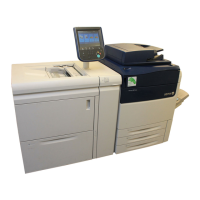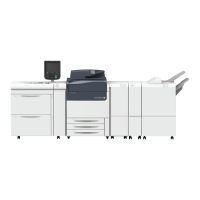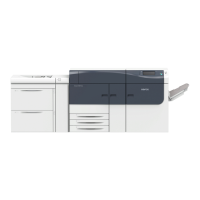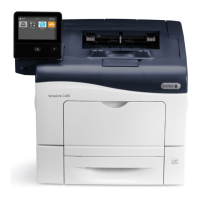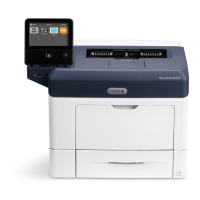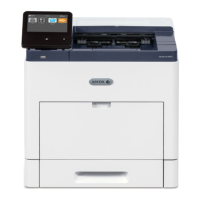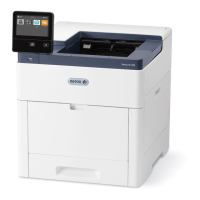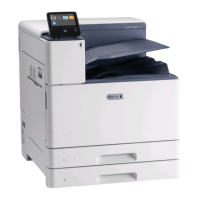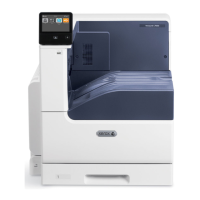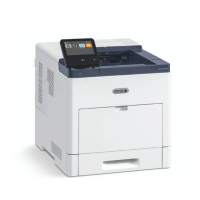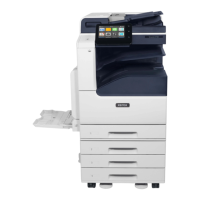Maintenance and Support Xerox
®
Versant™ 2100 Press
Customer Expectation and Installation Guide Xerox Confidential 24
3 Maintenance and Support
Customer/Operator Maintenance
Full Width Array Expectations
The Full Width Array enables automation of several common image quality management tasks. These procedures are "automated" in that they eliminate the
need for an operator to manually scan target sheets using an external device and manually update or store system values. The Full Width Array procedures must
be initiated by an operator at either the Print Server or at the Press Control Panel. All target sheets are then generated and scanned automatically, and all
measurements, calculations, and corrections are performed automatically. For several of the Full Width Array processes, manual inspection of a confirmation
print is required. The Full Width Array does not monitor or make adjustments within a print job.
The billing meters will be incremented for pages generated by the Full Width Array procedures. This is no change from the manual procedures. Refer to the
following procedures that are enabled by the Full Width Array:
TIP: These procedures are listed in the order in which we recommend they are performed.
Automatic Density Uniformity Adjustment (if required)
Automatic Image-to-Media Alignment (if required)
Print Server Calibration - Automated Color Quality Suite (ACQS)
Advanced Profiling - ACQS
Automatic Density Uniformity Adjustment
This procedure must be initiated by an operator at the Press Control Panel.
Density Uniformity Adjustment is done to ensure even toner density across the page (inboard-to-outboard). This is particularly important for high area
coverage applications where uniformity from edge-to-edge is more critical.
Once this process is initiated, the press automatically prints density test patterns, measures inboard-to-outboard density values, and corrects for variations by
adjusting print engine software controls.
This process does not monitor density within a print run. It is used prior to a shift or a print run to correct any existing variations in density across a page.
Automatic Density Uniformity should be run after xerographic components (photoreceptor drum, charge corotron) are replaced or if inboard-to-outboard
density uniformity defects are observed.
Use white paper. Gloss and paper weight meet the centerline criteria for the range of stocks you plan to run.
This procedure includes a manual inspection step to confirm quality. Inspect quality on the confirmation print, not the targets. If the confirmation print not
acceptable after auto-adjustment, then the customer should retry the routine. If still unacceptable a service call will be necessary.
Automatic Image-to-Media Alignment
This procedure must be initiated by an operator at the press Stock Library Manager application on the Print Server.
This process helps to ensure correct positioning of the print image on the media and is important for setting up new stock types. This is particularly useful when
front-to-back registration is critical to a job.
When this process is initiated, the press automatically prints test patterns, measures them, and makes automatic adjustments to registration, skew,
perpendicularity, and magnification.
This procedure should be run when using new papers, especially when image-on-media registration and front-to-back registration are critical, or if an alignment
problem (registration, skew) is observed.
The registration profile that is established is optimized for a particular paper tray. If a media is being run from multiple tray locations, the Image-to-Media
Alignment procedure should be used for each media/tray combination.
Use a naming convention for the profiles to help ensure that the correct profile is applied to the media/tray being used (Example: PaperType_Tray_Date).
Alignment profiles may need to be rerun or updated following changes in temperature or humidity or following a service procedure to a paper tray. Periodic
updates to alignment profiles is also required – the frequency of which depends on the criticality of registration for the job in question.
This procedure includes a manual inspection step to confirm quality. Inspect quality on the confirmation print, not the targets. If the confirmation print is not
acceptable after auto-adjustment, retry the routine. If still unacceptable, a manual setup will be required.
Print Server Calibration - Automated Color Quality Suite (ACQS)
Automatic Print Server Calibration is a component of the Xerox Automated Color Quality Suite (ACQS) and is enabled with the Full Width Array. This procedure
must be initiated by an operator at the print server.
All digital color presses require periodic image quality assessment and maintenance to deliver consistent color over time. Standard color maintenance
procedures should include periodic Calibration to set gray balance, which returns the print engine to a nominal state.
Automated Calibration is accomplished in two to three minutes per halftone (line screen) using the Full Width Array.
The external (handheld) spectrophotometer that is included with each print server can still be used for manual print server calibration, if preferred.
Calibration frequency depends in part on customer preference; however, the following guidelines apply:
- We recommend that Calibration be performed daily.
- Calibration should always be performed after service procedures or if any drift in color is detected.
- During a regular 8-hour shift, many customers calibrate at least once for each halftone used during that shift and many customers calibrate more frequently to
mitigate potential drift.
- Calibration should be performed using your most commonly used paper stock, or a centerline stock with mid-range weight and coating within the set of stocks you
typically use.
Each time Automatic Calibration is activated, the target sheets are printed, scanned and ejected to the purge tray location (for example, the Offset Catch Tray
or the top tray of a High Capacity Stacker). Each purge tray location has a capacity of 500 sheets (based on 120 gsm stock). When performing Automatic
Calibration, a full tray will cause a jam to occur. In most cases, once the jam is cleared, the printer will be able to resume calibration. If the Automatic
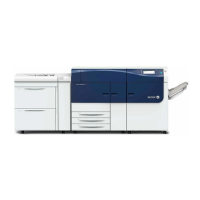
